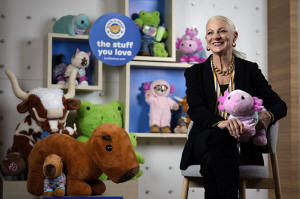Capybaras take their turn as the holiday season's 'it' animal
 Send a link to a friend
Send a link to a friend
 [December 19, 2024]
By DEE-ANN DURBIN, TERESA CRAWFORD and JEFF ROBERSON [December 19, 2024]
By DEE-ANN DURBIN, TERESA CRAWFORD and JEFF ROBERSON
ST. LOUIS (AP) — The world’s largest rodent is having a big moment.
The capybara – a semi-aquatic South American relative of the guinea pig
-- is the latest in a long line of “it” animals to get star treatment
during the holiday shopping season.
Shoppers can find capybara slippers, purses, robes and bath bombs. There
are cuddly plush capybaras and stretchy or squishy ones. Tiny capybaras
wander across bedding, T-shirts, phone cases, mugs, key chains and
almost any other type of traditional gift item.
Last year, it was the axolotl that took pride of place on many products,
and the endangered amphibian remains popular. Owls, hedgehogs, foxes and
sloths also had recent turns in the spotlight.
Trendy animals and animal-like creatures aren’t a new retail phenomenon;
think the talking Teddy Ruxpin toys of the 1980s or Furby and Beanie
Babies a decade later. But industry experts say social media is
amplifying which animals are hot — or not.
“It’s really the launch on TikTok, Instagram and other social media
platforms that allow these characters or animals to blow up like crazy,”
said Richard Derr, who has owned a Learning Express Toys franchise in
Lake Zurich, Ill., for nearly 30 years and is also a regional manager
for the specialty toy store chain.

Social media is also speeding up the cycle. Must-have animals may only
last a season before something new captures customers’ imaginations.
“It’s really important to keep feeding that beast,” Juli Lennett, a vice
president and toy industry advisor at market research firm Circana,
said. “If you are an influencer, you’re not going to talk about last
year’s stuff.”
Skyrocketing plush toy sales – fueled by a need for comfort during the
pandemic – are also increasing the demand for new and interesting
varieties, Lennett said. In the first nine months of this year, sales of
plush animals were up 115% from the same period in 2019, she said.
Overall toy sales rose 38% in that time.
Consumers are seeking out increasingly exotic species that they see in
online videos, games and movies. Highland cows, red pandas and axolotls,
a type of salamander native to Mexico, have all popped up in popular
culture. According to Google Trends, searches for axolotls shot up in
June 2021 after Minecraft added them to its game.
“Nobody knew what an axolotl was in 2020,” Derr said. “Now, everybody
knows axolotls.”
Cassandra Clayton, a Vermont Teddy Bear Company product designer, said
rising sales to adults are also fueling the demand for unique – and
collectible – plush toys.
“Stuffed animals are really becoming an ageless item,” she said.
“Especially with the boom of self-care in adults and turning towards
comfort objects to help de-stress and relax in your life.”
[to top of second column]
|

Sharon Price John, President and CEO of Build-A-Bear Workshop, poses
for a photo Thursday, Dec. 12, 2024, in St. Louis. (AP Photo/Jeff
Roberson)
 Clayton expects demand for unusual
stuffed animals to continue to grow. Among the oddest she has seen:
a stuffed version of a water bear, a type of microorganism also
known as a moss piglet or a tardigrade.
“It doesn’t necessarily inspire you to cuddle with them, but you’re
really seeing the industry start turning towards those characters,”
she said. “I think that’s the next trend.”
Figuring out the next “it” animal – or microorganism -- is a
challenge for toy makers.
“You never know exactly when they’re going to hit and how big
they’re going to be,” said Sharon Price John, the president and CEO
of Build-A-Bear Workshop, a chain of nearly 500 stores that offers
an expanding menagerie of animals and characters for customers to
customize, including capybaras and axolotls.
The St. Louis-based company watches social media and gets ideas from
talking to store employees and patrons, John said. It usually takes
Build-A-Bear up to a year to introduce a new stuffed toy, she said,
but the company can move faster if it spots a trend. It sometimes
tests a small batch online to make sure a trend is sticking, John
said.
Annual trade shows in Asia, Germany and elsewhere are another place
to spot new trends. Punirunes – digital, interactive pets that also
come in plush varieties – are big in Japan right now and will likely
take off in the U.S., toy store owner Derr said.
“Here, I can’t give them away. They’re too new. But give it a year
or two,” he said.
Companies can kick off their own trends too. Build-A-Bear’s Spring
Green Frog, introduced in 2020, was an immediate hit thanks to
videos posted by customers. It remains popular, with nearly 2
million sold, John said.

John suspects people are drawn to friendly, slow-moving capybaras
because watching videos of them are so relaxing. But shoppers who
want one need to act fast. A Build-A-Bear holiday capybara with red
and green sprinkles on its fur – dubbed a “cookiebara” – has already
sold out, she said.
___
Durbin reported from Detroit. Crawford reported from Lake Zurich,
Ill.
All contents © copyright 2024 Associated Press. All rights reserved |